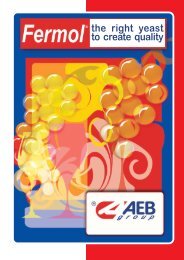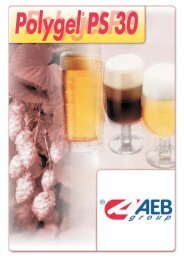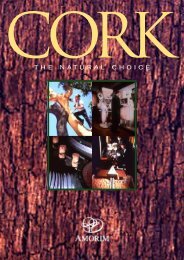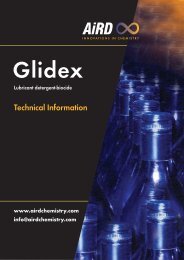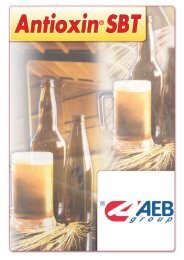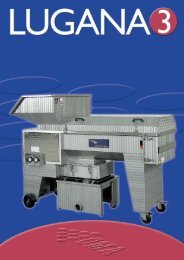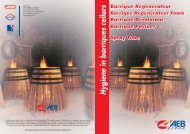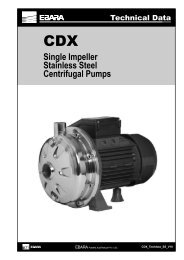Linvasan - SWAT
Linvasan - SWAT
Linvasan - SWAT
- No tags were found...
Create successful ePaper yourself
Turn your PDF publications into a flip-book with our unique Google optimized e-Paper software.
<strong>Linvasan</strong>Tartaric peroxyacid biocideINNOVATIONS IN CHEMISTRYContentsProduct InformationPage 3 Description and applicationFeatures and benefits4 Directions for UsePre-commencement informationChemical dosing and mixing procedure5 Sanitising ProcedureSIP SystemBathing parts and fittingsPrecautionsPackaging, storage and handlingProduct SpecificationPage 6 IdentificationPropertiesOther dataMaterial Safety DataPage 7 Section 1 - Material ID and supplier2 - Hazards identification3 - Composition and information on ingredients8 Section 4 - First aid measures5 - Fire fighting measures9 Section 6 - Accidental release measures7 - Handling and storage8 - Exposure controls, personal protection10 Section 9 - Physical and chemical properties10 - Stability and reactivity11 - Toxicological information12 - Ecological information13 - Disposal considerations11 Section 14 - Transport information15 - Regulatory information12 Section 16 - Other informationWine Industry Support Enterprises Pty Ltd © Page 2 of 12
<strong>Linvasan</strong>Tartaric peroxyacid biocideINNOVATIONS IN CHEMISTRYProduct InformationDirections for usePRE-COMMENCEMENT INFORMATIONWaterRainwater is the optimum for the sanitising cycle.Potable mains water can also be used as any chlorine component will be neutralised by <strong>Linvasan</strong>.Sterile rain water is the optimum for a final rinse cycle (though not required) if it is a part of your procedures.Water temperatureIdeal water is of ambient temperature of
<strong>Linvasan</strong>Tartaric peroxyacid biocideINNOVATIONS IN CHEMISTRYProduct InformationSanitising ProcedureSIP SYSTEMEnsure that your tank has been thoroughly cleaned of wine soils.Selected the dose quantity of <strong>Linvasan</strong> and prepare the aqueous <strong>Linvasan</strong> solution.Pump circulate it through the stainless steel tank and applied fittings using your system for about 5-10 minutesto effectively disinfect the internal surfaces of bacteria, yeast and mould.Algae and fungal growths will require a stronger solution with a longer solution contact time and may requiremechanical action from brushing, scrubbing or scouring to remove them.Drain the solution after the treatment. No rinse is required.Sterilise wine transfer and bottling lines use water-steam at 90-95°C as a final daily precursor process beforecommencing any bottling.BATHING PARTS AND FITTINGS<strong>Linvasan</strong> can be used also as a soaking disinfectant for pre-cleaned sundry stainless steel fittings and accessoriesin cold water in a term soak bath at the same rates w/v as above.The performance of <strong>Linvasan</strong> is strong in either of the 2 methods above, but if it contacts protein and otherorganic matter it strength diminishes and thus, should not be saved and re-used as a biocide. The regular useof <strong>Linvasan</strong> will show a noticeable improvement in the quality of your stainless steel surfaces.PrecautionsRead all of the Material Safety Data before using this product.We advocate that care is taken when using chemical cleaning products.• Wear appropriate work clothing, footwear, gloves, and safety glasses at all times whilst handling andin use.• Do not immerse hands in this product, or solutions of this product for prolonged periods.• Avoid contact with the eyes.• Keep out of the reach of childrenPackaging, storage and handlingPackagingBlack 5kg HDPE DG BottleBlack 15kg HDPE DrumBlue/Black 200kg HDPE DG dual bung DrumOrder Code - BSL105Order Code - BSL115Order Code - BSL1200Where possible, all containers are supplied with a Tamper Evident venting closure.HDPE = High Density PolyethyleneStorageStore in a dry, cold place (10-20°C), out of sunlight, away from heat and isolated from alkalis and foodstuffs.To maintain your product in good condition, replace and seal any caps or plugs on containers after each use.Do not cover, seal over or replace any venting caps or plugs.HandlingHandle with care so not to damage the container(s) or violently agitate the stored product.Wine Industry Support Enterprises Pty Ltd ©Page 5 of 12
<strong>Linvasan</strong>Tartaric peroxyacid biocideINNOVATIONS IN CHEMISTRYProduct SpecificationIdentificationCompany AiRD-Innovations in Chemistry ®Wine Industry Support Enterprises Pty LtdProduct NameCodeSuggested useSummaryLINVASANBSL1Dissolved in an aqueous solution to disinfect bacteria, yeast and other pathogens fromstainless steel and associated surfaces in one process.A translucent, colourless, fine aqueous tartaric peracid biocide.PropertiesAppearanceA clear colourless fine liquidpH value
<strong>Linvasan</strong>Tartaric peroxyacid biocideINNOVATIONS IN CHEMISTRYMaterial Safety DataSection 1Material identification and supplierProduct Name LINVASANOther namesNo other namesProduct code BSL1Laboratory file AL001Document released July 2002 – New FormatCurrent Update May 2007Suggested use In an aqueous solution to disinfect bacteria, yeast and other pathogens from stainlesssteel and associated surfaces in one process.SummaryA translucent, colourless, fine aqueous tartaric peracid biocide.Company AiRD-Innovations in Chemistry ®Wine Industry Support Enterprises Pty Ltd ACN 099 644 416Telephone International + 61 8 8285 9100Fax International + 61 8 8285 7099E-mailPostalinfo@airdchemistry.comUnit 1, 102 Rundle Rd.,Salisbury South,South Australia 5106Emergency Telephone - Australia 0417 894 682Section 2Hazards identificationClasssification Hazardous product. Dangerous Goods.CORROSIVE, OXIDISING (C)/(O) – Class 8, Sub-Risk 5.1Risk Phrases R22 Harmful if swallowedR36, R38 Irritating to the eyes and skinSafety Phrases S2 Keep out of the reach of childrenS15Keep container away from heatS18Handle and open container with careS24, S25 Avoid contact with the skin and eyesS37, S39 Wear suitable gloves and eye/face protectionPoisons Schedule S5Section 3Composition and information on ingredientsA mixture from HG demineralised water CAS 7732-18-5Tartaric acid CAS 87-69-4Hydrogen peroxide CAS 7722-84-1Proprietary chelating-stabiliserFurther referencesAustralian Inventory of Chemical Substances (AICS),Chemical Abstract Service (CAS)Wine Industry Support Enterprises Pty Ltd © Page 7 of 12
<strong>Linvasan</strong>Tartaric peroxyacid biocideINNOVATIONS IN CHEMISTRYMaterial Safety DataSection 4First Aid FacilitiesIngestionEyeSkinInhaledAdvice to DoctorHealth effectsFirst aid measuresEye and hand washing station, safety showerWill cause nausea, vomiting, bleeding and severe stomach distortion and pain.Immediately rinse the mouth thoroughly with water. Give plenty of water to drink.Do not induce vomiting. If vomiting occurs wash out the mouth with water provided thevictim is conscious.Urgent hospital treatment is likely to be needed. Seek immediate medical advice orcontact the Poisons Information Centre – Australia 131 126 for advice.The eyes are particularly sensitive to this product in its concentrated form.Likely to cause eye irritation on short term contact, or ocular burns if contact is sustained.Immediately irrigate with copious amounts of water for at least 15 minutes while holdingeyelids open. Seek Medical advice if irritation persists.Will irritate the skin on contact and may cause redness or a transient burn in the formof a whitening of the skin.Remove any contaminated clothing. Wash affected skin with plenty of soap & water.If irritation persists seek Medical advice.Launder or wash any contaminated clothing before re-use.Not expected to be a source of exposure.Vapours of the concentrate may irritate the respiratory tract in some people.If a person is affected by vapours remove the victim from the source of exposure tofresh air. Allow the patient to assume the most comfortable position. Seek Medicaladvice if symptoms persist.Treat symptomatically.If a significant quantity is swallowed large amounts of oxygen may be released quickly.No available information.Section 5Specific hazardsFire-fighting adviceExtinguishing mediaFire fighting measuresThis product is stable and non-flammable and non-combustible when stored in a cold,dry location.Chemical extinguishers may accelerate decomposition.Decomposes on heating liberating oxygen.Heating will cause decomposition which can lead to containers rupturing violently orexploding.If safe to do so, remove any containers from the path of any fire.Fire fighters to wear self-contained breathing apparatus and full protective clothing ifthere is a risk of exposure to the products of decomposition.Keep the containers cool with water spray.If this material is involved in a fire use water spray.Wine Industry Support Enterprises Pty Ltd © Page 8 of 12
<strong>Linvasan</strong>Tartaric peroxyacid biocideINNOVATIONS IN CHEMISTRYMaterial Safety DataSection 6Accidental release measuresFor large spills ensure that the cleanup is conducted by trained personnel.Do not touch any of the spilled material.Evacuate all unnecessary personnel.Wear appropriate protective equipment including boots, safety glasses, chemical resistant gloves.Try to contain liquid spills within a bund. Heavily dilute <strong>Linvasan</strong> with water and contain in a prepared bund.Allow the aqueous mixture to degrade naturally.Alternatively, collect and contain the spilt material by brooming on hard surfaces such as concrete or bitumen.Soak up with an inert absorbent such as earth or sand and scoop, place and seal the material in properlylabelled containers or drums for disposal according to the local regulations.Wash-down affected area with plenty of water, but avoid discharging aqueous waste run-off into naturalwaterways.Pools of aqueous solutions of the product concentrate on hard surfaces may be slippery.For small spills mop up and rinse all surfaces with clean water.Section 7Handling and storageHandle all packages with due care. Refer Sec.10 – Stability & Reactivity.Store in a dry, ventilated, cold place (
<strong>Linvasan</strong>Tartaric peroxyacid biocideINNOVATIONS IN CHEMISTRYMaterial Safety DataSection 9Physical and chemical propertiesPhysical state Clear fine liquidColourColourlessOdourMild acid-peroxideMolecular formula Not applicableSolubilitySoluble in waterSpecific Gravity 1.16gm/cm3 (water = 1) approxFlash Point (°C) Not applicable, non-flammablepH2.1 approx. (1% w/v aqueous solution)FP Range 1.5 - 0°CSection 10Stability and reactivityThis material is stable when stored correctly and used as recommended.If stored continuously at high temperatures, i.e. >30°C it will commence to degrade.Exposure to continuous hot conditions of higher temperatures (35-45°C) then the product can commence tostrongly degrade which will result in the situation as described on the Australian Standard EPG -8D1 for theseGoods - "Heat may cause violent rupture of containers".Although this product will not burn, principally due to its water content, it contains Hydrogen Peroxide (ChemFormula H2O2), the components of which will support combustion.Polymerisation is not expected.Section 11Toxicological informationNo adverse health effects are expected if the product is handled in accordance with this safety data informationand the product label.Symptoms or effects that can arise if this product is mishandled are discussed in Section 4 – First Aid Measuresas above.The product is a strong irritant for the eyes and for the skin and respiratory tract as a concentrate.Long term effectsToxicological dataCarcinogenicityMutagenicityNo information available for this product. No adverse health effects are expected fromaccumulative work exposure to this product.No information availableThe materials are not classified as carcinogenic.The product is non-mutagenic, non teratogenic. The components of this product willnot give rise to birth defects.Section 12Ecological informationAvoid contaminating the environment with concentrated material.Avoid disposal to natural waterways with concentrated non-neutralized solutions.DegradabilityEco-toxicityAqueous solutions of this product are biodegradable (< 30days).In a dilute, neutralized, aged aqueous solution it is not expected to harm marine oraquatic life.Predominantly degrades to oxygen and hydrogen.Section 13Disposal ConsiderationsRefer to the Waste Management Authority. Dispose of through a licensed waste contractor.Wine Industry Support Enterprises Pty Ltd © Page 10 of 12
<strong>Linvasan</strong>Tartaric peroxyacid biocideINNOVATIONS IN CHEMISTRYMaterial Safety DataSection 14Transport InformationLabelRoad/Rail TransportMarine TransportIn accordance with the NOH&SC ‘Code of Practice’ for workplace substances.Classified as Dangerous Goods by the criteria of the Australian Dangerous GoodsCode (ADG Code) for transport of by road & rail.Classified as Dangerous Goods by the criteria of the International Maritime DangerousGoods Code (IMDG Code) for transport by sea.Codes UN No. 3093DG Class 8Subsidiary Risk 5.1Poisons Schedule 5Packaging Group 2Hazchem CodeEPG (AS 2931)2X8D1 – Corrosive, Oxidising, N.O.S.This product should not be loaded or packed in the same vehicle as;All Fire risk substances, combustible liquids, foodstuffs, food packaging,Explosives Class 1Flammable gases, Toxic gases Class 2.1, 2.3Flammable liquids, solids,Combustible substances Class 3Dangerous when wet substances Class 4.1, 4.2, 4.3Oxidising agents, Organic peroxides Class 5.1, 5.2Toxic substances Class 6Miscellaneous Dangerous Goods Class 9Section 15Regulatory informationClassification This product is hazardous according to the criteria of NOHSC.CORROSIVE, OXIDISING (C)/(O) – Class 8, Sub-Risk 5.1Risk Phrases R22 Harmful if swallowedR36, R38 Irritating to the eyes and skinSafety Phrases S2 Keep out of the reach of childrenS15Keep container away from heatS18Handle and open container with careS24, S25 Avoid contact with the skin and eyesS37, S39 Wear suitable gloves and eye/face protectionChemical Materials are listed on the AICS.Wine Industry Support Enterprises Pty Ltd © Page 11 of 12
<strong>Linvasan</strong>Tartaric peroxyacid biocideINNOVATIONS IN CHEMISTRYMaterial Safety DataSection 16Other informationRegistry of Toxic Effects of Chemical SubstancesEd.D.Sweet, US Dept of Health and Human Services: Cincinatti 2002.Hawley’s Condensed Chemical Dictionary 12 th EditionLewis, Richard J. Sr.: New York 1993.Approved Criteria for classifying Hazardous SubstancesNational Code of Practice for the Labelling of Workplace SubstancesWorksafe Australia-National Occupational Health and Safety Commission.MSDS – Hydrogen peroxideMSDS – Tartaric acidSuppliers - All sourcesDISCLAIMERThis MSDS summarises, to our best knowledge at the date of issue, the chemical health and safety hazardsof this product and general guidance on how to handle the material in the workplace.If clarification or further information is needed, the user should contact the Company on the materials andsupplier information on page 1 herein.This information is supplied in good faith, but since data, safety standards & Government regulations are subjectto change and as the conditions of handling and use or misuse are beyond our control, we make no warranty,either express or implied, with respect to the completeness or accuracy of the information contained hereinsubsequent to the time of compilation.Wine Industry Support Enterprises Pty Ltd © Page 12 of 12



